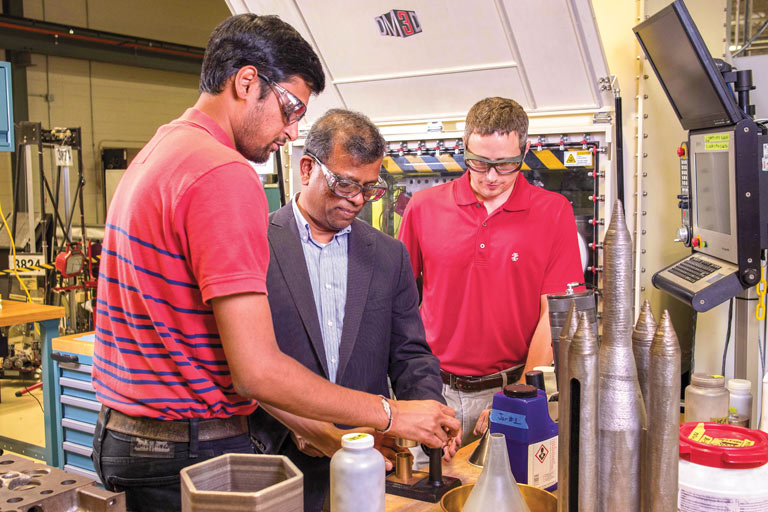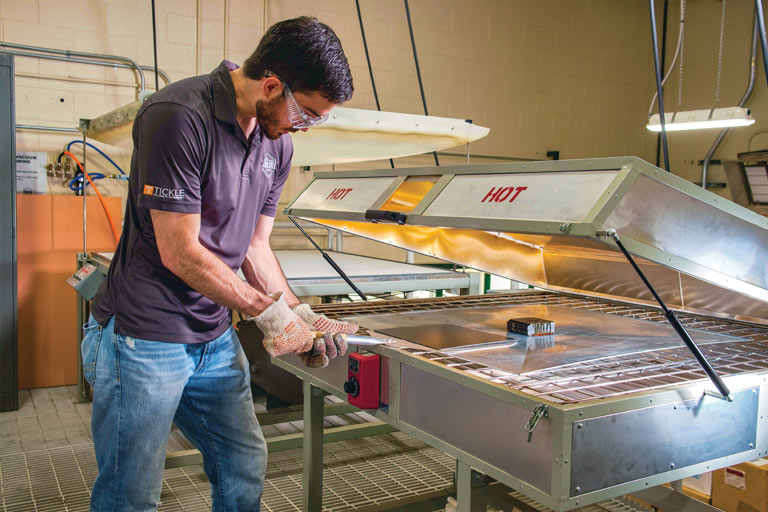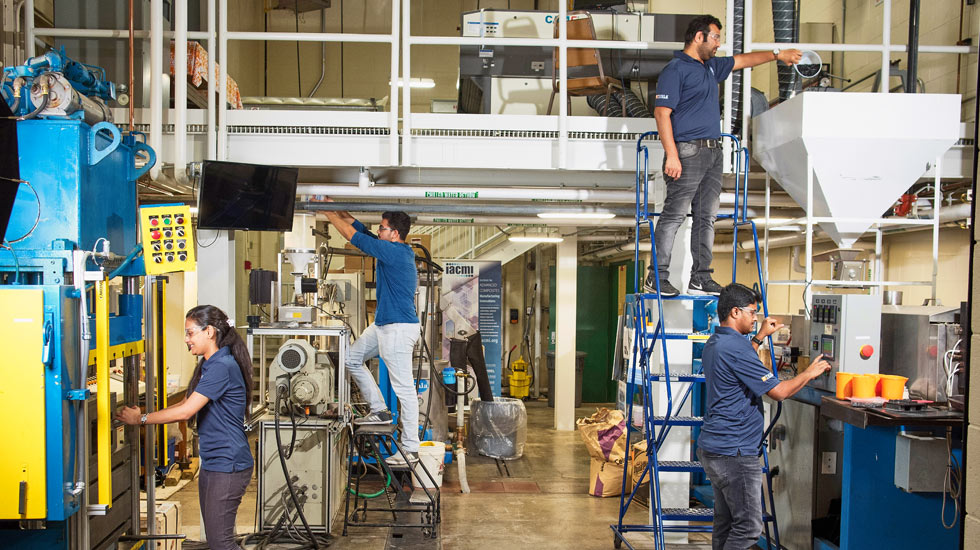Manufactured Advancement
To be a specialist only requires you to be good in one or two areas. To be a leader takes pushing the boundaries of innovation across a wide range of initiatives.
And that’s what is taking place in Tennessee due to the unique partnership between UT and Oak Ridge National Laboratory (ORNL).
“We’ve made big progress, even in just the last five years,” said Suresh Babu, UT-ORNL Governor’s Chair for Advanced Manufacturing. “We went from zero people specifically focused on advanced manufacturing to a point where faculty in the Tickle College of Engineering, the College of Arts and Science, the College of Architecture and Design, the UT Space Institute, the UT Institute of Agriculture, and several directorates at ORNL all now bring a wealth of expertise to the table.”
Advanced manufacturing (AM) is the future, and UT and ORNL have teamed together to lead the way forward in this area of critical national importance through strategic hires, innovative initiatives, and world-class laboratories.

Multi-Institution Partnerships
IACMI—The Composites Institute, which is a collection of universities, states, and research centers with UT as the lead institution, is the best known AM partnership at UT. Other key national initiatives involving UT include:
- Lightweight Innovations for Tomorrow was founded by The Ohio State University, the University of Michigan, and EWI with a focus on lightweight manufacturing. Other partners include the US Department of Defense, General Electric, Lockheed Martin, MIT, and Penn State University, among others.
- America Makes is the country’s leading advanced manufacturing and 3D printing consortium. Four US departments, the National Science Foundation, NASA, Boeing, and the Air Force Research Laboratory are among its members.
- Advanced Functional Fibers of America—is a $317 million public-private partnership led by MIT that aims to speed up the development of new fibers and textiles for production in the US.
- The Manufacturing and Materials Joining Innovation Center, housed at Ohio State, is focused on the development of new materials, new joining processes and techniques, and new ways to automate AM.
- High Performance Computing for Manufacturing is a major program between ORNL and Lawrence Livermore National Laboratory in California with the goal of harnessing exascale computing to improve AM.
“We’re working closely with UT to strengthen the region’s scientific leadership and to develop the next generation of researchers for the future of manufacturing,” said Moe Khaleel, ORNL’s associate laboratory director for Energy and Environmental Sciences.
“The lab’s signature strengths in materials, neutrons, and computational science are essential as we tackle the nation’s biggest technology challenges,” Khaleel added. “ORNL is home to the Department of Energy’s Manufacturing Demonstration Facility and Carbon Fiber Technology Facility—dedicated to developing breakthroughs for additive manufacturing and carbon fiber and composites.
“Working with universities like UT has also allowed us to significantly advance collaborations such as IACMI—The Composites Institute that demonstrate America’s scientific ingenuity.”
From Knoxville to Tullahoma, from carbon fibers to composites, researchers at those organizations are reshaping the way we think of manufacturing, taking the lead in projects covering everything from the future of flight to the security of the country.
“Even though our core disciplines are different, we’ve come together, centered on a common focus of advanced manufacturing, composites, and additive manufacturing, and are recognized as leaders in the field,” added Babu.
The result bolstered not just the institutions, but the regional economy as well.
“Advanced manufacturing is growing in importance, not only to the University of Tennessee, but to the state and to the world at large,” said Stacey Patterson, UT’s vice president for research. “Supporting new initiatives in this field isn’t just an investment in the university; it’s an investment in our future.”
Marc Gibson, UT’s senior director for corporate engagement, pointed out several statistics that highlight the role AM is playing in shaping the state’s economy, noting that 350,000 Tennesseans are employed in some form of the field.
In fact, AM now accounts for more than 16 percent of the state’s GDP, accounting for more than $55 billion in goods and services in 2017.
While funding research initiatives in AM is key, UT’s work in that arena also helps the state in another way.
“Our initiatives help support the state’s renaissance by developing and graduating an educated, well-skilled workforce,” Gibson said. “It also allows UT to form collaborations with industry and government partners to push the boundaries of innovation.”
The Bredesen Center
Through this UT-ORNL center, graduate students like Vidya Kishore can work on AM research initiatives taking place at UT and ORNL. Read about Vidya’s research.
Major Projects
Babu was the first of three appointments to the UT-ORNL Governor’s Chair program that were made with a specific focus on AM, along with Uday Vaidya, Governor’s Chair for Advanced Composites Manufacturing, Easo George, the Governor’s Chair for Advanced Alloy Theory and Development, and Art Ragauskas, the Governor’s Chair for Biorefining. Babu and George work through the Department of Mechanical, Aerospace, and Biomedical Engineering (MABE), while George works in the Department of Materials Science and Engineering and Ragauskas is housed in the Department of Chemical and Biomolecular Engineering.
UT-NASA Partnership
Recognizing UT’s expertise, NASA is partnering with the university to combat the challenges of off-planet manufacturing during space travel. Specifically, the goal is to figure out how to utilize whatever materials happen to be available as base elements, be that moon dust or asteroid particles.
Since moon dust is only so similar to materials found on Earth, NASA is counting on UT Assistant Professors Jeffrey Reinbolt, of MABE, to come up with a way to use them effectively.
Another challenge? AM printers and the consistency of materials used on Earth don’t work in space due to a lack of gravity. To solve those riddles, UT has developed an extrusion-based printer that uses a material that is 70 percent solid, keeping it from floating away in a micro-gravity environment. Critically, the printer can be “aimed” in any direction to allow for as-needed production in the often-cramped confines of space modules.
Since coming to UT in 2013, Babu has earned the university representation on or leadership of several high-profile projects, the most recent of which was his selection as leader of the first Multi University Research Initiative award given to UT in the program’s 30-year history.
Both the international team of universities he is leading—which includes the Ohio State University and Virginia Tech University—and the focus of the project—improving materials the United States Navy uses in its ships—highlight the importance of the work and the validation of UT’s role in the field.
“We’re helping the Navy develop new, more reliable alloys, yes, but the work we are doing will impact all advanced manufacturing processes involving metal and the use of high-energy deposition,” said Babu. “Our work in better understanding the properties of these alloys directly impacts national security at many levels.”
While Babu has the sea covered, work through the UT Space Institute (UTSI) will revolutionize the way we journey through the skies. The US Air Force selected a team to investigate and overcome barriers related to hypersonic flight, which is faster than a speeding bullet at roughly 3,800 miles per hour.
While such speeds would allow flight times of less than two hours from Atlanta to Tokyo, they have two major problems: intense heat and pressure.
With such obvious benefits hanging in the balance for the Air Force, it was important that they have the right people on the team. Enter John Schmisseur, the H. H. Arnold Chair in Computational Fluid Dynamics and B. H. Goethert Professor at UTSI.
“We will gain an understanding of how that heat builds and distributes, and the pressures it places on aircraft,” said Schmisseur. “The combined knowledge and resources we have within the UT system will allow us to craft a solution.”
To accomplish those goals, Schmisseur and his team won’t just call upon UT’s expertise in advanced materials, but also one of the largest wind tunnels in use in academia, yet another critical advantage for the university. Read about their project.
Ask the Expert
Brett Compton, assistant professor of mechanical, aerospace, and biomedical engineering, recently talked about the UT-ORNL advantage when it comes to the future of advanced manufacturing. Learn about the advantages of our partnership with ORNL.
Hands-On Experience
Speak to any faculty involved in advanced manufacturing at UT, and the value placed on opening up opportunities for students quickly becomes clear.
Thanks to the world-class facilities at UT and ORNL, UT engineering students also get hands-on experience with projects that directly impact society.

Across the College
Although many AM activities trace back to mechanical engineering, every one of the college’s departments has at least some involvement in the field. Current research efforts include using AM for sustainable energy (CBE), using polymeric composites to create a breakthrough “smart” joint system using a new type of adhesive (CEE), merging AM techniques with lean manufacturing to help reduce costs while boosting performance and production (ISE), exploring the properties and behavior of advanced materials (MSE), producing novel materials for use in semiconductors (EECS), and studying the structure and effects of radiation on advanced materials used in a nuclear environment (NE).
One such area is the light-weighting of machinery and materials, which increases the strength of materials while reducing the weight, cost, and energy requirements of vehicles, industrial machinery, and biomedical devices.
Other projects at UT include using composites to help a home manufacturing company design and build custom “bamboo” flooring, aiding an auto manufacturer in developing a new air braking system, and even teaming up with one business to improve the recycling of carbon fiber itself.
UT’s Fibers and Composites Manufacturing Facility provides a specific example of how research, education, and experience come together.
There, Vaidya has developed a cutting-edge research space that opens up the world of AM to students of all levels, including 20 undergraduates and 15 graduate students.
“We teach them about a variety of materials, how to use them, how to take fibers, resins, and additives to composites to components,” Vaidya said. “We promote thinking outside the box and collaboration. We’ve made the space a melting pot of work and interaction.”

Growing AM Materials
Agriculture isn’t the first thing most people would associate with AM, but UT’s Center for Renewable Carbon could change that. Housed in the UT Institute of Agriculture (UTIA), the center is a leader in biofuels, biomaterials, and biorefining research.
UTIA faculty, researchers from ORNL, and UT-ORNL Governor’s Chair Ragauskas are exploring ways of using plant-based materials to produce supplies of cutting-edge goods, including bio-based carbon fiber. Having an endless supply of materials to make carbon fiber will ensure the AM revolution will be well supported for years to come.
In Vaidya’s group alone, students work on projects with partners ranging from small-scale manufacturers to industry giants like Volkswagen, often reinforcing their classwork by interning with those same companies.
Having such a wide array of opportunities is a hallmark of advanced manufacturing education at UT, something the faculty takes very seriously.
“Many others are good in one way or another,” said Hu. “We’re good in a comprehensive way, across many areas.”
Moving advanced manufacturing forward. Energizing the next generation of researchers, workers, and scientists. Building world-class knowledge, innovation, and faculty.
Leading. It’s what UT does.
